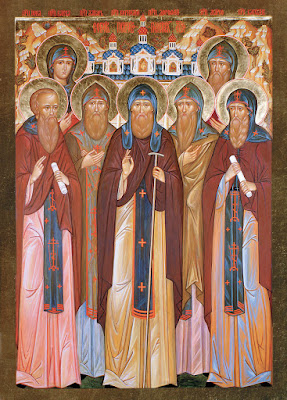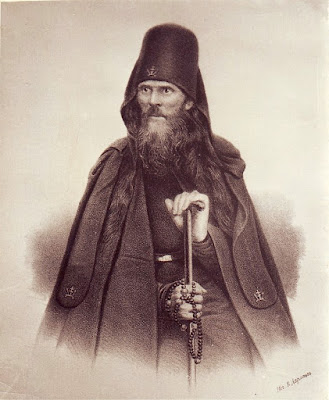By St. Gregory the Wonderworker
It is our duty to present to God, like sacrifices, all the festivals and hymnal celebrations; and first of all, the annunciation to the holy mother of God, to wit, the salutation made to her by the angel, "Hail, thou that art highly favoured!" For first of all wisdom and saving doctrine in the New Testament was this salutation, "Hail, thou that art highly favoured!" conveyed to us from the Father of lights. And this address, "highly favoured," embraced the whole nature of men. "Hail, thou that art highly favoured" in the holy conception and in the glorious pregnancy, "I bring you good tidings of great joy, which shall be to all people." And again the Lord, who came for the purpose of accomplishing a saving passion, said, "I will see you, and you shall rejoice; and your joy no man takes from you." And after His resurrection again, by the hand of the holy women, He gave us first of all the salutation "Hail!" And again, the apostle made the announcement in similar terms, saying, "Rejoice evermore: pray without ceasing: in everything give thanks." See, then, dearly beloved, how the Lord has conferred upon us everywhere, and indivisibly, the joy that is beyond conception, and perennial. For since the holy Virgin, in the life of the flesh, was in possession of the incorruptible citizenship, and walked as such in all manner of virtues, and lived a life more excellent than man's common standard; therefore the Word that comes from God the Father thought it meet to assume the flesh, and endue the perfect man from her, in order that in the same flesh in which sin entered into the world, and death by sin, sin might be condemned in the flesh, and that the tempter of sin might be overcome in the burying of the holy body, and that therewith also the beginning of the resurrection might be exhibited, and life eternal instituted in the world, and fellowship established for men with God the Father. And what shall we state, or what shall we pass by here? Or who shall explain what is incomprehensible in the mystery? But for the present let us fall back upon our subject. Gabriel was sent to the holy virgin; the incorporeal was dispatched to her who in the body pursued the incorruptible conversation, and lived in purity and in virtues. And when he came to her, he first addressed her with the salutation, "Hail, thou that art highly favoured! The Lord is with you." Hail, thou that art highly favoured! For you do what is worthy of joy indeed, since you have put on the vesture of purity, and are girt with the cincture of prudence. Hail, thou that art highly favoured! For to your lot it has fallen to be the vehicle of celestial joy. Hail, thou that art highly favoured! For through you joy is decreed for the whole creation, and the human race receives again by you its pristine dignity. Hail, thou that art highly favoured! For in your arms the Creator of all things shall be carried. And she was perplexed by this word; for she was inexperienced in all the addresses of men, and welcomed quiet, as the mother of prudence and purity; (yet) being a pure, and immaculate, and stainless image herself, she shrank not in terror from the angelic apparition, like most of the prophets, as indeed true virginity has a kind of affinity and equality with the angels. For the holy Virgin guarded carefully the torch of virginity, and gave diligent heed that it should not be extinguished or defiled. And as one who is clad in a brilliant robe deems it a matter of great moment that no impurity or filth be suffered to touch it anywhere, so did the holy Mary consider with herself, and said: Does this act of attention imply any deep design or seductive purpose? Shall this word "Hail" prove the cause of trouble to me, as of old the fair promise of being made like God, which was given her by the serpent-devil, proved to our first mother Eve? Has the devil, who is the author of all evil, become transformed again into an angel of light; and bearing a grudge against my espoused husband for his admirable temperance, and having assailed him with some fair-seeming address, and finding himself powerless to overcome a mind so firm, and to deceive the man, has he turned his attack upon me, as one endowed with a more susceptible mind; and is this word "Hail" (Grace be with you) spoken as the sign of gracelessness hereafter? Is this benediction and salutation uttered in irony? Is there not some poison concealed in the honey? Is it not the address of one who brings good tidings, while the end of the same is to make me the designer's prey? And how is it that he can thus salute one whom he knows not? These things she pondered in perplexity with herself, and expressed in words. Then again the archangel addressed her with the announcement of a joy which all may believe in, and which shall not be taken away, and said to her, "Fear not, Mary, for you have found favour with God." Shortly have you the proof of what has been said. For I not only give you to understand that there is nothing to fear, but I show you the very key to the absence of all cause for fear. For through me all the heavenly powers hail you, the holy virgin: yea rather, He Himself, who is Lord of all the heavenly powers and of all creation, has selected you as the holy one and the wholly fair; and through your holy, and chaste, and pure, and undefiled womb the enlightening Pearl comes forth for the salvation of all the world: since of all the race of man you are by birth the holy one, and the more honourable, and the purer, and the more pious than any other: and you have a mind whiter than the snow, and a body made purer than any gold, however fine, and a womb such as the object which Ezekiel saw, and which he has described in these terms: "And the likeness of the living creatures upon the head was as the firmament, and as the appearance of the terrible crystal, and the likeness of the throne above them was as the appearance of a sapphire-stone: and above the throne it was as the likeness of a man, and as the appearance of amber; and within it there was, as it were, the likeness of fire round about."















































